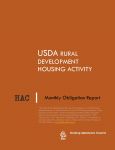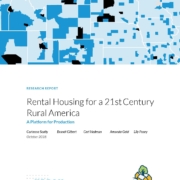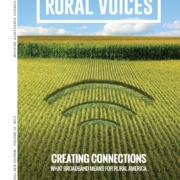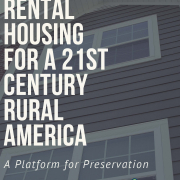HAC News: October 25, 2018
HAC News Formats. pdf
October 25, 2018
Vol. 47, No. 22
EARLY BIRD RATE ENDS OCTOBER 31 FOR 2018 HAC RURAL HOUSING CONFERENCE• Comments on USDA income banding proposal due October 30, HAC posts draft response • Proposed regulations released for Opportunity Zones • HUD reports homelessness fell in cities over past ten years, increased in suburban and rural areas • Indian Community Development Block Grant funds available • Information from HAC’s Community Reinvestment Act webinar posted • USDA used all Section 502 direct funding in FY 2018, Section 504 fell short • Water infrastructure bill becomes law • Census data guide the targeting of over $30 billion in federal funds per year for rural areas • New poll shows rural optimism, mixed with concern for jobs and the opioid epidemic • Changes proposed for H-2A temporary farmworker visa forms • Economic growth is uneven within rural and urban places, not just between rural and urban, researcher notes •Framing the conversation helps build support for affordable housing • Interactive maps show who’s most impacted by Hurricane Florence • Almost one-quarter of housing tax credit units may lose affordability by 2030, says new report • Housing tax credit target area designations released
HAC News Formats. pdf
October 25, 2018
Vol. 47, No. 22
EARLY BIRD RATE ENDS OCTOBER 31 FOR 2018 HAC RURAL HOUSING CONFERENCE.
Register now for the conference, to be held December 4-7 at the Capital Hilton in Washington, DC. HUD Secretary Ben Carson is confirmed as one of the keynote speakers.
Comments on USDA income banding proposal due October 30, HAC posts draft response.
On August 31 USDA published a proposed rule for its single-family housing direct loan and grant programs that would adopt a two-tier income limit structure, revise the methodology to determine area loan limits and make other changes. The proposed change to the income limit structure is intended to minimize the observed disconnect between minimum wages and the low median income in many areas. The proposed change to the methodology is intended to streamline the process and improve the reliability of the data set used to establish the area loan limits. HAC agrees that these are desirable goals, but HAC’s draft comment letter expresses concern that the proposed solutions will divert limited program resources to applicants with much higher incomes. HAC strongly urges USDA to take positive steps to assure the program continues to serve those who are most in need.
Proposed regulations released for Opportunity Zones.
The IRS’s proposed regulations and other guidance were released on October 19, explaining how individuals, corporations and others can delay or eliminate capital gains taxes by investing in Qualified Opportunity Funds that undertake development in designated Opportunity Zones. Comments will be due 60 days after publication in the Federal Register, which has not yet been scheduled. The IRS will hold a public hearing on the proposal on January 10, 2019. For more information, contact Erika C. Reigle, IRS, 202-317-7006.
HUD reports homelessness fell in cities over past ten years, increased in suburban and rural areas.
The first part of HUD’s 2017 Annual Homeless Assessment Report, released in December, focused on people who were homeless on a single night in January 2017. The just-released second part presents nationwide data on those who were homeless at any time during fiscal year 2017. It includes figures for rural (nonmetropolitan) areas, usually combining them with numbers for suburbs. From 2007 to 2017, the share of people experiencing homelessness decreased in principal cities from 76.9% to 72.5% and increased in suburban and rural areas from 23.1% to 27.5%, while the shares of population and poverty population did not change.
Indian Community Development Block Grant funds available.
Tribal governments and tribal organizations can apply by January 7, 2019 for HUD ICDBG grants to provide housing, living environments, or economic opportunities primarily for low- and moderate-income people. For more information, contact HUD staff.
Information from HAC’s Community Reinvestment Act webinar posted.
A recording and slides from HAC’s October 24 webinar on “Proposed Changes to CRA – What Does it Mean for Rural America?” is posted online. Comments on the proposed CRA changes are due to the Office of the Comptroller of the Currency by November 19.
USDA used all Section 502 direct funding in FY 2018, Section 504 fell short.
USDA obligated about $1.1 billion for 7,199 Section 502 direct loans, up from $999.99 million (7,187 loans) last year. Obligations to very low-income borrowers accounted for 33% of that total, less than last year’s 38%. Only 71% of the $28 million available for Section 504 homeowner repair loans was used, along with 94% of the $30 million for Section 504 grants; there were 206 fewer loans than in FY17 and 178 fewer grants. On the multifamily side, USDA obligated the entire $1.35 billion available for 268,514 Section 521 Rental Assistance units. Last year, it funded 302,451 units ($1.37 billion). There were also 6,353 rural housing vouchers totaling $26.7 million in FY18, compared to last year’s 5,609 vouchers representing $22.0 million. More information is provided in HAC’s obligation report, and a more detailed HAC report on FY18 performance is forthcoming.
Water infrastructure bill becomes law.
On October 23, President Trump signed into law the bipartisan Water Infrastructure Act of 2018. Intended to provide safe drinking water for communities across the country, the act includes new programs with specific priorities benefiting rural Americans.
Census data guide the targeting of over $30 billion in federal funds per year for rural areas.
The annual total for all 320 census-guided federal assistance programs – including those that are not specifically rural – was $850 billion in FY16, according to George Washington University’s Institute of Public Policy, which presented findings and other details to the Congressional Rural Caucus on October 11. For more information, contact Prof. Andrew Reamer, GWU, 202-994-7866.
New poll shows rural optimism, mixed with concern for jobs and the opioid epidemic.
According to a new poll from National Public Radio, the Robert Wood Johnson Foundation and the Harvard T.H. Chan School of Public Health, rural Americans are largely concerned about opioids and economic conditions in their communities, but are optimistic overall. Eight in 10 said they feel their lives are turning out either as expected, or better. Nationally 25% of rural residents cited drug addiction/abuse as the biggest problem facing their community, compared to 21% who cited economic concerns.
Changes proposed for H-2A temporary farmworker visa forms.
The Department of Labor has suggested revisions to the forms and information employers submit to DOL for its determination whether U.S. farmworkers are available and whether conditions for U.S. workers would be affected by hiring workers from other countries through the temporary H-2A visa program. Comments are due in mid-December. For more information, contact William W. Thompson II, DOL, 202-513-7350.
Economic growth is uneven within rural and urban places, not just between rural and urban, researcher notes.
Rural America is not a monolithic entity mired in economic depression while urban/suburban areas are thriving, writes scholar Richard Florida in the first of a series of articles for CityLab. Other pieces in the series cover jobs, economic mobility, and wages, with future items on the urban-rural divide expected to cover population growth, college grads, and the knowledge-based creative class.
Framing the conversation helps build support for affordable housing.
Finding a Frame for Affordable Housing, by the FrameWorks Institute and Enterprise Community Partners, presents research findings and a companion piece, Piecing it Together: A Framing Playbook for Affordable Housing Advocates, illustrates ways for advocates to use these techniques in their communications. The authors recommend describing housing and development issues in terms of fairness.
Interactive maps show who’s most impacted by Hurricane Florence.
Maps for North and South Carolina, posted along with information about the need for civil legal aid after disasters, show where vulnerable groups such as children, people with disabilities, farmworkers and more live in the storm-affected parts of the states.
Almost one-quarter of housing tax credit units may lose affordability by 2030, says new report.
Balancing Priorities: Preservation and Neighborhood Opportunity in the Low Income Housing Tax Credit Program Beyond Year 30, published by the National Low Income Housing Coalition and the Public and Affordable Housing Research Corporation, reports that the Low Income Housing Tax Credit has financed about 3 million affordable rental housing units nationwide. Federal law requires most of them to remain affordable for at least 30 years, with some states extending the affordability period beyond that. Eleven percent of these properties, and 5.6% of the units, also have loans from USDA’s Section 515 program. Nationwide, almost 500,000 LIHTC units will reach the 30-year mark by 2030. Around the same time, unless preventive action is taken, rural places will also experience significant annual loss of Section 515 properties, as detailed in HAC’s recent report, Rental Housing for a 21st Century Rural America: A Platform for Preservation.
Housing tax credit target area designations released.
HUD has published its annual designations of Difficult Development Areas and Qualified Census Tracts for purposes of the Low Income Housing Tax Credit. For more information, contact Michael K. Hollar , HUD, 202-402-5878.
HAC offers Section 502 packaging training in December.
This three-day advanced course trains experienced participants to assist potential borrowers and work with RD staff, other nonprofits, and regional intermediaries to deliver successful Section 502 loan packages. The training will be held December 5-7 in Washington, DC (simultaneously with HAC’s conference). For more information, contact HAC staff , 404-892-4824.
Need capital for your affordable housing project?
HAC’s loan funds provide low interest rate loans to support single- and multifamily affordable housing projects for low-income rural residents throughout the U.S. and territories. Capital is available for all types of affordable and mixed-income housing projects, including preservation, farmworker, senior, and veteran housing. HAC loan funds can be used for pre-development, site acquisition, site development, and construction/rehabilitation. Contact HAC’s loan fund staff at hacloanfund@ruralhome.org, 202-842-8600.
Please note: HAC is not able to offer loans to individuals or families. Borrowers must be nonprofit or for-profit organizations or government entities (including tribes).





